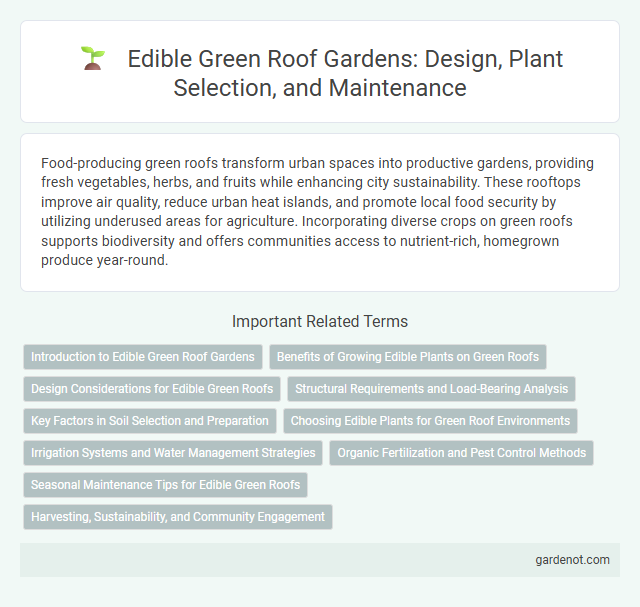Food-producing green roofs transform urban spaces into productive gardens, providing fresh vegetables, herbs, and fruits while enhancing city sustainability. These rooftops improve air quality, reduce urban heat islands, and promote local food security by utilizing underused areas for agriculture. Incorporating diverse crops on green roofs supports biodiversity and offers communities access to nutrient-rich, homegrown produce year-round.
Introduction to Edible Green Roof Gardens
Edible green roof gardens transform urban rooftops into productive agricultural spaces, enhancing food security and biodiversity. These systems integrate lightweight growing mediums, drought-tolerant plants, and efficient irrigation to support vegetables, herbs, and fruit crops. By utilizing underused roof areas, edible green roofs contribute to sustainable city living and local food production.
Benefits of Growing Edible Plants on Green Roofs
Growing edible plants on green roofs enhances urban food security by providing fresh, nutritious produce directly where people live. This practice reduces the carbon footprint associated with food transportation and improves air quality through increased photosynthesis. Rooftop gardens also promote biodiversity and contribute to urban temperature regulation by providing natural insulation and reducing the heat island effect.
Design Considerations for Edible Green Roofs
Design considerations for edible green roofs include ensuring appropriate soil depth and quality to support a variety of food-producing plants such as vegetables, herbs, and fruit-bearing species. Structural load capacity must be assessed to accommodate the additional weight of moist growing media and mature plants while integrating efficient irrigation and drainage systems to maintain optimal moisture levels. Sunlight exposure and microclimate factors are critical for maximizing crop yield and selecting suitable plant varieties for rooftop food production.
Structural Requirements and Load-Bearing Analysis
Food-producing green roofs demand robust structural requirements to support the added weight of soil, plants, and water retention systems, typically requiring a load-bearing capacity of at least 150 to 300 pounds per square foot. Engineers conduct comprehensive load-bearing analysis involving dead loads from the substrate and live loads from plant growth, irrigation, and harvesting activities to ensure roof integrity and prevent structural failure. Incorporating lightweight growing mediums and optimizing plant selection reduces overall weight, enhancing the feasibility of retrofitting existing buildings for urban agriculture.
Key Factors in Soil Selection and Preparation
Soil selection for food-producing green roofs must prioritize lightweight, nutrient-rich substrates with excellent water retention and drainage properties to support plant health and growth. Key factors include a balanced pH, adequate organic matter, and the presence of essential macro and micronutrients to promote crop yield and resilience. Proper preparation involves sterilizing soil to prevent pathogens and incorporating amendments like compost or biochar to enhance fertility and structural stability.
Choosing Edible Plants for Green Roof Environments
Selecting edible plants for green roofs requires prioritizing species that tolerate shallow soil, high wind exposure, and variable temperatures. Hardy herbs like thyme, chives, and mint, along with lightweight vegetables such as salad greens and dwarf tomatoes, are ideal for rooftop cultivation. Incorporating native fruiting plants can enhance biodiversity while providing fresh, nutrient-rich produce in urban agricultural settings.
Irrigation Systems and Water Management Strategies
Food-producing green roofs utilize efficient irrigation systems such as drip irrigation and automated sensors to optimize water use and reduce waste. Advanced water management strategies incorporate rainwater harvesting and greywater recycling to maintain adequate moisture levels while promoting sustainability. These techniques enhance plant health, increase crop yield, and contribute to urban water conservation efforts.
Organic Fertilization and Pest Control Methods
Organic fertilization on food-producing green roofs enhances soil fertility using compost, manure, and biofertilizers that promote sustainable nutrient cycling. Natural pest control methods such as introducing beneficial insects, companion planting, and using neem oil or insecticidal soaps reduce chemical reliance and protect plant health. These eco-friendly practices support robust crop growth, improve biodiversity, and maintain the environmental benefits of green roofs.
Seasonal Maintenance Tips for Edible Green Roofs
Seasonal maintenance for edible green roofs involves regular pruning of vegetable plants and herbs to promote healthy growth and prevent overcrowding. Monitoring soil moisture levels and adjusting watering schedules ensures optimal hydration while avoiding root rot, especially during dry or rainy seasons. Removing fallen leaves and debris helps prevent pest infestations and maintains a clean environment for productive food cultivation.
Harvesting, Sustainability, and Community Engagement
Food-producing green roofs enhance urban sustainability by providing fresh, locally grown produce while reducing carbon footprints and urban heat islands. Efficient harvesting techniques maximize crop yield and quality, supporting year-round food availability and minimizing food waste. These rooftops foster community engagement through shared gardening spaces and educational programs, promoting environmental awareness and social cohesion.
Food-producing roof Infographic

 gardenot.com
gardenot.com